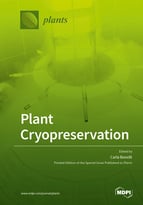Plant Cryopreservation
A special issue of Plants (ISSN 2223-7747). This special issue belongs to the section "Plant Physiology and Metabolism".
Deadline for manuscript submissions: closed (31 May 2021) | Viewed by 36840
Special Issue Editor
Interests: micropropagation; in vitro conservation; cryopreservation; synthetic seed technology; TIS bioreactor
Special Issues, Collections and Topics in MDPI journals
Special Issue Information
Dear Colleagues,
Cryopreservation is the storage of cells, tissues, and organs at ultra-low temperature (liquid nitrogen, −196 °C). Crop diversity and wild relatives need to be conserved for future generations, but traditional storage conditions do not provide the extreme longevities that are needed to minimize risk of loss. Therefore, cryopreservation can be an important tool for long-term conservation of plant genetic resources. Under cryogenic storage, all metabolic activities and cell divisions are stopped and the biological material can be preserved for a long period. So far, a wide range of cryogenic procedures have been developed for in vitro explants and non-orthodox seeds in many plant species; however, research that provides novelty, insight, and advances for developing and improving of new protocols in plant species is still needed.
This Special Issue will be devoted to research dealing with plant cryopreservation, including development of new protocols, physical and chemical aspects of freezing and drying, cold adaptation, post-thawing regrowth, and investigation of problems related to preservation in liquid nitrogen.
Dr. Carla Benelli
Guest Editor
Manuscript Submission Information
Manuscripts should be submitted online at www.mdpi.com by registering and logging in to this website. Once you are registered, click here to go to the submission form. Manuscripts can be submitted until the deadline. All submissions that pass pre-check are peer-reviewed. Accepted papers will be published continuously in the journal (as soon as accepted) and will be listed together on the special issue website. Research articles, review articles as well as short communications are invited. For planned papers, a title and short abstract (about 100 words) can be sent to the Editorial Office for announcement on this website.
Submitted manuscripts should not have been published previously, nor be under consideration for publication elsewhere (except conference proceedings papers). All manuscripts are thoroughly refereed through a single-blind peer-review process. A guide for authors and other relevant information for submission of manuscripts is available on the Instructions for Authors page. Plants is an international peer-reviewed open access semimonthly journal published by MDPI.
Please visit the Instructions for Authors page before submitting a manuscript. The Article Processing Charge (APC) for publication in this open access journal is 2700 CHF (Swiss Francs). Submitted papers should be well formatted and use good English. Authors may use MDPI's English editing service prior to publication or during author revisions.
Keywords
- long term-conservation
- liquid nitrogen
- cold adaptation
- desiccation tolerance
- slow cooling
- vitrification-based procedures
- encapsulation
- embryogenic culture
- embryonic axes
- seeds
- shoot tips
- zygotic embryos
- post-thawing regrowth
- ex situ conservation
- plant biodiversity







